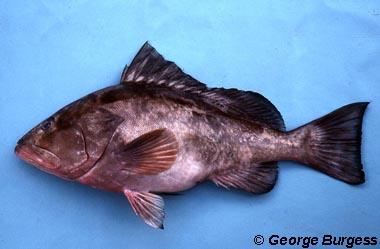
Epinephelus morio
This stout, almond-shaped fish is a dark reddish brown on top, fading to a lighter pink underneath, with lighter spots and blotches across its body and darker margins to its fins. It has large, round eyes over a pointed snout, and a continuous spiny dorsal fin that ends at the square caudal (tail) fin. They all start life as females, and most turn into males between 7 and 14 years old. They prefer sitting on the muddy bottoms of coastal waters on the Western Atlantic where they can grow to around 4 feet long.
Order: Perciformes
Family: Serranidae
Genus: Epinephelus
Species: morio
Common Names
English language common names for this species include red grouper, brown grouper, hamlet, and deer grouper. Common names in other languages are cherna (Spanish), cherna americana (Spanish), cherna de arribada (Spanish), cherna de arribazon (Spanish), cherna de corrida (Spanish), cherna de veril (Spanish), cherna de vivero (Spanish), cherna grande (Spanish), cherna roja (Spanish), cherna yucateca (Spanish), garoupa (Portuguese), garoupa de Sao Tomé (Portuguese), garoupa vermelha-de-abrolhos (Portuguese), garoupa-bichada (Portuguese), garoupa-de-segunda (Portuguese), garoupa-verdadeira (Portuguese), garoupa-vermelha (Portuguese), garoupa-vermelha-dos-Abrolhos (Portuguese), granik morio (Polish), jaboncillo (Spanish), mero (Spanish), mero americano (Spanish), mero cherna (Spanish), mero guasa (Spanish), mero paracamo (Spanish), mérou nègre (French), mérou rouge (France), meru (Papiamento), nègre (French), nogue couleur rouge (French), piragia (Portuguese), punameriahven (Finnish), roter grouper (German), rød havaborre (Danish), tsumagurohata (Japanese), and vieille rouge (French).
Importance to Humans
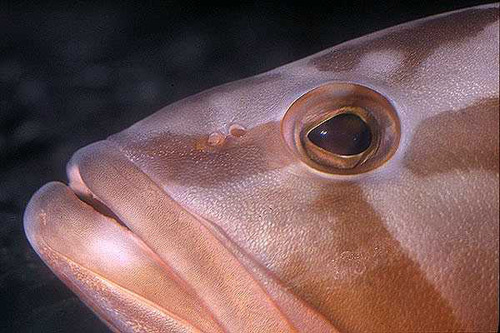
This grouper is fished commercially as well as well as recreationally. Populations of red grouper are considered overfished and undergoing overfishing in the northeastern and southern portions of the Gulf of Mexico with large declines in some areas. Harvest in US waters has decreased by over 50% in the last 55 years. If management practices do not lead to improvement of stock, this species should be considered in the future as “Vulnerable” by the IUCN (World Conservation Union) Red List.
Danger to Humans
There have been reported cases of ciguatera from human consumption of red grouper. Ciguatera poisoning is caused by dinoflagellates (microalgae) found on dead corals or macroalgae. By feeding on these corals and macroalgae, herbivorous fishes accumulate a toxin generated by these dinoflagellates. Largely a phenomenon of tropical marine environments, ciguatoxin accumulates still further in snappers and other large predatory reef species that feed on these herbivorous fishes. If accumulated levels of the toxin are great enough they can cause poisoning in humans whom consume the flesh of these fishes. Poisoned people report having gastrointestinal problems for up to several days, and a general weakness in their arms and legs. It is very rare to be afflicted with ciguatera poisoning.
Conservation
Populations of this grouper have been heavily impacted by overfishing. Further compounding the situation is the huge numbers of juvenile red groupers that are captured as bycatch and killed by shrimp trawlers.
> Check the status of the red grouper at the IUCN website.
The IUCN is a global union of states, governmental agencies, and non-governmental organizations in a partnership that assesses the conservation status of species.
Geographical Distribution
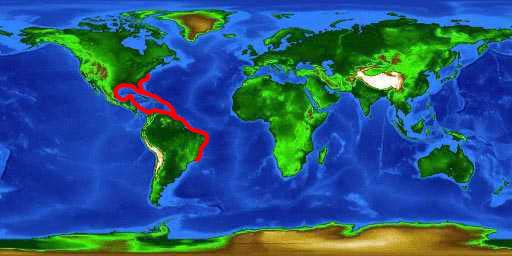
The distribution range of the red grouper is limited to the western Atlantic Ocean from North Carolina (US) south to southern Brazil including the Gulf of Mexico and the Caribbean Sea. It is occasionally sighted in waters as far north as Massachusetts (US).
Habitat
This non-migratory fish is associated primarily with muddy and rocky bottom habitats at depths of 16-1,083 feet (5-330 m) and they are often seen resting on the bottom substrate. Juvenile red groupers reside in seagrass beds in shallower waters until they reach larger sizes when they move out to rocky bottom and reef habitats.
Biology
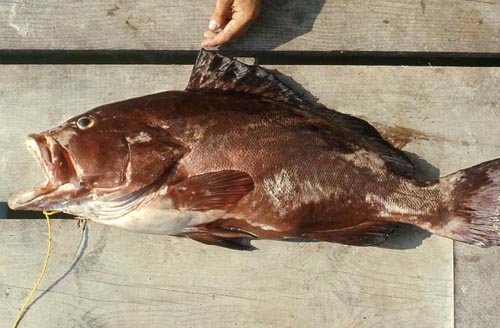
Distinctive Features
The red grouper is a robust fish of moderate size. It has large eyes and the differ in size, with the anterior pair slightly smaller then the posterior pair. The pelvic fins are shorter than the pectoral fins. The pelvic fins are inserted posterior to the pectoral fins on the body. Red grouper have scales and thick skin located at the base of the soft dorsal and anal fins. The caudal fin is truncate and the caudal peduncle lacks a saddle.
Sometimes confused with other members within the genus Epinephelus, the red grouper can be distinguished by the large size of its dorsal fin and the absence of a notch on the interspinous membrane. In particular, this grouper’s pectoral fins being longer than the pelvic fins distinguishes it from the Warsaw grouper (E. nigritus), the yellow-edged grouper (E. flavolimbatus), and the misty grouper (E. mystacinus). Also, their pectoral fins are inserted posterior to the pelvic fins in contrast to the red grouper whose pelvic fins are inserted posterior to the pectoral fins.
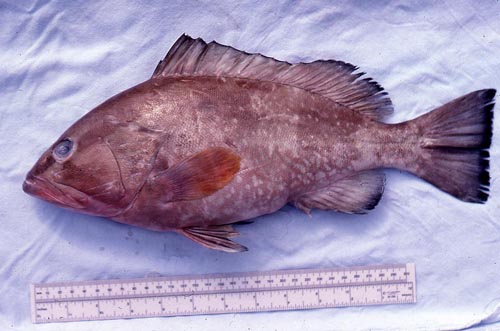
Coloration
The head and the body of the red grouper are dark reddish brown in color fading to a pink or reddish color on the lateral sides and ventral side. Light colored blotches and spots may be seen scattered on the body and small black dots may be present around the eyes. The anal, dorsal, and caudal fins have dark margins. When the fish is resting, the coloration becomes more banded in appearance, resembling the Nassau grouper (E. striatus).
Dentition
Groupers have several sets of strong, slender teeth that act as raspers. These teeth are not used to tear flesh as with the barracudas and sharks, but rather to prevent small fish from escaping.
Size, Age, and Growth
The red grouper reaches a maximum reported total length of 4 feet (125 cm) and a maximum reported weight of 51 pounds (23.0 kg). Females reach sexual maturity at 4-6 years of age while males are considered reproductively significant at 10 years of age and older. Red groupers are believed to have a lifespan of approximately 25-30 years.
Food Habits
Prey items of the red grouper include various marine invertebrates such as crabs, shrimp and octopi as well as fish such as snappers and parrotfish. Red grouper is known to be very susceptible to red tide poisoning.
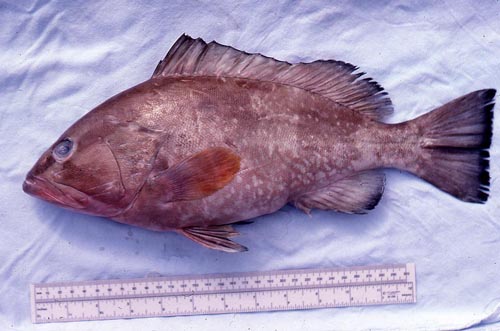
Reproduction
The red grouper is a protogynous hermaphrodite with all fish beginning life as females. Most of the females transform to males between 7 and 14 years of age, sometime after reaching at least 23 inches in length. Spawning occurs during the months of January through April in the Gulf of Mexico and the Caribbean Sea. During spawning events, the fish release their sperm and eggs in offshore water. The fertilized eggs require high salinity (32 ppt) to maintain their buoyancy. The eggs hatch into larvae approximately 30 hours after spawning and live as part of the zooplankton with the ocean currents. The larvae settle out of the zooplankton to the bottom substrate at about 35-50 days after hatching, correlating to a standard length of 20-25 mm. As early juveniles, they feed primarily upon demersal crustaceans living in seagrass beds. Larger fishes feed heavily upon juvenile red groupers. As the juveniles mature, they move out to deeper rocky bottoms and feed upon smaller fishes as well as a variety of invertebrates. The fish portion of their diet increases as the red groupers increase in size.Predators
Top predators such as sharks and barracudas prey upon adult red groupers. Juvenile red groupers fall prey to demersal fishes.
Parasites
Red groupers are hosts to many parasites. A recent study reported one onogenean, three cestodes, seventeen trematodes, eight nematodes, and one acanthocephalan as parasites of this species. A new trematode, Allonematobothrium yucatanense sp. n., was described from the fins of the red grouper during this study. In addition, the nematode, Philometra margolisi, parasitizes the gonads and is believed to affect the reproduction of the red grouper in aquaculture.
Taxonomy
The red grouper was originally described as Serranus morio by Valenciennes in 1828. This name was later changed to the currently valid Epinephelus morio (Valenciennes 1828). Synonyms for this species includeSerranus erythrogaster DeKay 1842, Serranus remotus Poey 1860, and Serranus angustifrons Steindachner 1864. The genus name, Epinephelus, is derived from the Greek “epinephelos” meaning cloudy.
Prepared by: Cathleen Bester